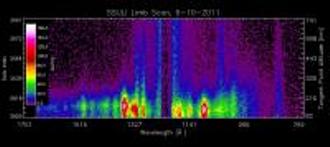The data from the NRL Spacecraft Engineering Department and Space Science Division’s Special Sensor Ultraviolet Limb Imager (SSULI) has been given official approval for use in the operational system at the AFWA (Air Force Weather Agency).
 This is an example scan from the SSULI instrument, x-axis represents wavelength, y-axis is altitude and the color represents accumulated counts in one orbit (101 minutes).
This is an example scan from the SSULI instrument, x-axis represents wavelength, y-axis is altitude and the color represents accumulated counts in one orbit (101 minutes).
The AFWA has received a formal letter recommending the usage of the SSULI information as inputs into Space Weather Models and also as Standalone data devices from the Defense Weather System Directorate at the Air Force Space & Missile System Center, after carrying out detailed validation of the SSULI sensor software & derived atmosphere specification.
Sean Lynch, who is the Program Manager for NRL, stated that these datasets, which were being used in AFWA, would give insights into the atmosphere for both civilian users and the Dept. of Defense. The SSULI takes measurements of the vertical profiles of the airglow radiation that comes from ions, atoms and molecules in the ionosphere and upper atmosphere layers from low earth orbit on board the DMSP satellite. It measures the neutral density and the electron density profiles of the emitting atmospheric components. It also takes measurements from the extreme ultraviolet to the far ultraviolet region.
The SSULI makes use of a spectrograph along with a mirror, which could scan below the satellite horizon from 10-27 degrees at intervals of 90 seconds. These inspections show the vertical slice of the atmosphere from a depth of 750 to 50 km. This data helps to develop new methods for global ionospheric remote sensing and also to creation new models pertaining to global electron density variation.
Andrew Nicholas, the principal investigator for the NRL –SSULI, revealed that the SSULI team was excited to observe the data obtained from the mission transition into operations, which was the outcome of the hard work put in by a team of exceptionally dedicated NRL engineers and scientists.